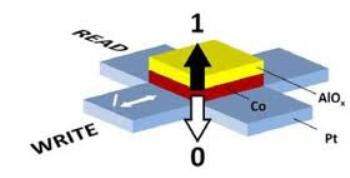Scientists from the Catalan Institute of Nanotechnology, ICREA, together with Universitat Autonoma de Barcelona, Pietro Gambardella, Kevin Garello, and Mihai Miron have collaborated with Gilles Gaudin and his colleagues at SPINTEC in Grenoble, France, have identified a new technique to write magnetic information on miniature magnetic bits, one after the other, rapidly with minimum consumption of energy.
 New Method of Writing Magnetic Data
New Method of Writing Magnetic Data
Magnetic fields created by coils and wires are currently used to perform magnetic writing. This method has several disadvantages with respect to energy efficiency and scalability. The new method does not require magnetic fields and allows reversible and very simple writing of memory data by introducing an electric current that is parallel to the axis of the magnetic bit. It is necessary to engineer asymmetric interfaces on the magnetic layer both at the bottom and top, which creates an electric field within the material. Here, a cobalt film measuring less than 1 nm in thickness was sandwiched between aluminum oxide and platinum.
Because of the fine relativistic effects, electrons effectively navigating the Co layer consider the electric field of the material as the magnetic field which reverses their magnetization. Based on the current intensity and the magnetization direction, it is possible to induce a magnetic field that is robust enough to twist the magnetization. Scientists demonstrated that this technique functions normally at room temperature utilizing current pulses existing in magnetic bits below 10 ns with 200 x 200 sq nm, when further rapid switching and miniaturization occur easily as expected.
An added benefit of this discovery is that current-stimulated magnetic writing is proficient in hard magnetic layers rather than soft layers because miniaturization of hard magnets to nanometer dimensions can be done without any loss in its magnetic properties.